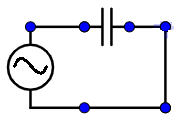Question
Question: In an a.c. circuit an alternating voltage \(e=200 \sqrt{2} \sin 100t\) volts is connected to a capac...
In an a.c. circuit an alternating voltage e=2002sin100t volts is connected to a capacitor of capacity 1μF. The r.m.s. value of the current in the circuit is:
A. 10 mA
B. 100 mA
C. 200 mA
D. 20 mA
Solution
The emf of the supply voltage is given in the question. Like a resistor, a capacitor also creates some voltage drop across. It has some 'impedance', which when multiplied by current gives the voltage drop across it.
Formula Used:
Capacitor's reactance (or resistance) is obtained as:
XC=ωC1
Complete step by step answer:
Given, the supply:
e=2002sin100t volts
And the value of C = 1μ F

We know that an alternating current source will have a supply voltage given by V0sinωt type of expression. We only compare this with our given supply voltage. The direct comparison gives us:
V0=2002 volts
and
ω=100 Hz
The reactance of the capacitor can be found by plugging in the values as:
XC=ωC1=100×10−61=10000 ohms
We know, by ohm's law that the current I in the circuit with resistance R and supply voltage V is just V/R. Similarly, we can write:
I0=XCV0
Thus,
I0=100002002A
But, we need to find the rms value of the current, so we use the formula:
Irms=2I0
Therefore, we can get:
Irms=1002A
Or, we can say:
Irms=20mA
Thus, the correct option (D). 20 mA. This is the value of rms ac current in the circuit consisting of 1μF capacitor.
Note:
If more components are present in the circuit, the situation becomes different. If two capacitors were present in series we had to use equivalent capacitance in the reactance formula. If a resistor would have been present we would have done some vector algebra as the current in a capacitor lags behind from a resistor.
